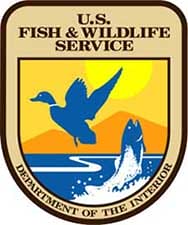

USA -(Ammoland.com)- The U.S Fish and Wildlife Service today announced it has finalized a rule that will help protect and conserve eagle populations through revised permitting processes and monitoring requirements.
The revised rule engages a variety of industries more fully in eagle conservation and helps the Service better understand how human activities across the landscape affect eagles.
The rule includes revisions to the permitting system for unintentional prohibited impacts to eagles and will help protect local populations by providing much-needed information to support greater scientific understanding and decision-making.
“No animal says America like the bald eagle, and the Service is using the best available science to make eagle management decisions that promote eagle conservation,” said Service Director Dan Ashe. “Our success in recovering this bird when its populations plummeted in the lower 48 nearly a half-century ago stands as one of our greatest national conservation achievements. The final revised regulations build on this success, taking a comprehensive approach to eagle conservation and demonstrating the Service’s longstanding commitment to bald and golden eagles, responsible industry operations, and the interests of the American people.”
Under the revised rule, permits may be granted only when the applicant agrees to specific measures to first reduce take to the greatest extent possible.
To protect local eagle populations, the Service uses precautionary, conservative estimates to arrive at the eagle take number for each permit, meaning fewer birds will likely end up being taken than are permitted.
The permittee also must agree to assume additional responsibility for monitoring eagle loss at its facilities, which is critical to developing a better understanding of ways impacts to eagles can be reduced in the future.
Changes to the regulations include a new requirement that monitoring for long-term permits be conducted by independent contractors who report directly to the Service and for their monitoring data to be made available to the public.
The maximum term for a permit is extended to 30 years, but longer-term permits will be closely re-evaluated every five years. After each five-year period, the permittee will need to review the permit and monitoring data with Service biologists to ensure permit terms are being maintained and eagle populations are conserved.
Other changes to the rule include revisions to permit issuance criteria, compensatory mitigation standards, criteria for eagle nest removal permits, permit application requirements, and fees.
The regulations guide the Service’s administration of the Bald and Golden Eagle Protection Act (Eagle Act).
Revisions to the rule, which was originally published in 2009, build on extensive public input and are supported by a significant body of science, including findings from a Service and U.S. Geological Survey initiative that began in 2011.
The findings represent a compilation of the most current research on the population status and trends of bald and golden eagles and serve as the biological basis for the final rule.
Incidental take of eagles (unintentional disturbance, injury or loss of eagles due to otherwise lawful activities) has been a longstanding issue.
An incidental take permit system – first under the Endangered Species Act, then the Eagle Act – has provided a way for companies or individuals to work collaboratively with the Service to lessen their impact and compensate for any unavoidable loss of eagles while also reducing their risk of being charged with violations of federal law.
Today, Americans can enjoy seeing more bald eagles than at any time in the past 50 years. Populations, nearly extinct in the lower 48 states in the 1960s, now number at least 143,000 individuals. In contrast, data suggest golden eagle populations are stable but may gradually decline.
Therefore, under the revised rule, any loss of golden eagles can be approved only with the application of actions that ensure there is no net loss of golden eagles.
“The impact of development on wildlife and their habitats can often be significantly reduced if there is the will and a framework to guide us,” Ashe noted. “The Service has a long history of working cooperatively with multiple industry sectors through the permitting system to reduce impacts to eagles and other federally protected wildlife species. Renewable energy development is increasing, reducing carbon emissions that jeopardize humans and wildlife through climate change. The Service is working with these and other interests to help them implement practices to site, design and operate facilities in ways that reduce impacts to eagles and other animals.”
For additional information and to view the final rule, click here.
The mission of the U.S. Fish and Wildlife Service is working with others to conserve, protect, and enhance fish, wildlife, plants, and their habitats for the continuing benefit of the American people.
We are both a leader and trusted partner in fish and wildlife conservation, known for our scientific excellence, stewardship of lands and natural resources, dedicated professionals, and commitment to public service.
For more information on our work and the people who make it happen, visit their website.
